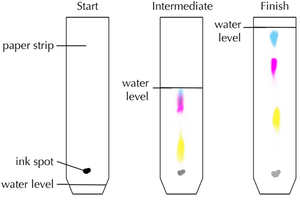Difference between revisions of "Chromatogram"
(→Key Stage 4) |
(→About Chromatograms) |
||
| (5 intermediate revisions by 2 users not shown) | |||
| Line 1: | Line 1: | ||
| + | ==Key Stage 3== | ||
| + | ===Meaning=== | ||
| + | [[File:ChromatographyDiagram2.png|right|300px|thumb|The [[chromatogram]] is on the far right having been produced in a [[chromatography]] [[experiment]].]] | ||
| + | A [[chromatogram]] is the result of a [[chromatography]] [[experiment]] showing the relative [[distance]]s moved by different [[chemical]]s in a [[sample]]. | ||
| + | |||
| + | ===About Chromatograms=== | ||
| + | [[Chromatogram]]s can be used to identify [[chemical]]s in an unknown [[mixture]] because different [[solute]]s [[diffusion|diffuse]] at different rates. | ||
| + | |||
==Key Stage 4== | ==Key Stage 4== | ||
===Meaning=== | ===Meaning=== | ||
| Line 8: | Line 16: | ||
*Comparing the [[chromatogram]] of a [[sample]] to the [[chromatogram]]s of known [[chemical]]s. | *Comparing the [[chromatogram]] of a [[sample]] to the [[chromatogram]]s of known [[chemical]]s. | ||
*Calculating the [[Retention Factor|Retention Factor (R<sub>f</sub>)]] of the [[chemical]]s in the [[sample]] and comparing it to known [[Retention Factor|R<sub>f</sub>]] values. | *Calculating the [[Retention Factor|Retention Factor (R<sub>f</sub>)]] of the [[chemical]]s in the [[sample]] and comparing it to known [[Retention Factor|R<sub>f</sub>]] values. | ||
| + | : [[Chromatography]] works because different [[solute]]s [[diffusion|diffuse]] at different rates. | ||
| + | |||
| + | ===References=== | ||
| + | ====AQA==== | ||
| + | |||
| + | :[https://www.amazon.co.uk/gp/product/0198359381/ref=as_li_tl?ie=UTF8&camp=1634&creative=6738&creativeASIN=0198359381&linkCode=as2&tag=nrjc-21&linkId=47c8d1ae58d8b3a5e2094cd447154558 ''Chromatograms, pages 182-183, GCSE Chemistry; Third Edition, Oxford University Press, AQA ''] | ||
| + | |||
| + | ====Edexcel==== | ||
| + | |||
| + | :[https://www.amazon.co.uk/gp/product/1292120193/ref=as_li_tl?ie=UTF8&camp=1634&creative=6738&creativeASIN=1292120193&linkCode=as2&tag=nrjc-21&linkId=572df39392fb4200db8391d98ae6314e ''Chromatogram, page 152, GCSE Combined Science, Pearson Edexcel ''] | ||
| + | :[https://www.amazon.co.uk/gp/product/1292120215/ref=as_li_tl?ie=UTF8&camp=1634&creative=6738&creativeASIN=1292120215&linkCode=as2&tag=nrjc-21&linkId=8f96ddb76196848bafdb124354e4cf77 ''Chromatogram, page 8, GCSE Chemistry, Pearson, Edexcel ''] | ||
| + | :[https://www.amazon.co.uk/gp/product/1782945725/ref=as_li_tl?ie=UTF8&camp=1634&creative=6738&creativeASIN=1782945725&linkCode=as2&tag=nrjc-21&linkId=694be7494de75af3349537d34e13f7f0 ''Chromatograms, page 40, GCSE Chemistry; The Revision Guide, CGP, Edexcel ''] | ||
| + | :[https://www.amazon.co.uk/gp/product/1782948147/ref=as_li_tl?ie=UTF8&camp=1634&creative=6738&creativeASIN=1782948147&linkCode=as2&tag=nrjc-21&linkId=f63dcd8345f4e49c717b39a228a36c7c ''Chromatograms, pages 108, 109, 111, GCSE Chemistry, CGP, Edexcel ''] | ||
| + | |||
| + | ====OCR==== | ||
| + | :[https://www.amazon.co.uk/gp/product/0198359829/ref=as_li_tl?ie=UTF8&camp=1634&creative=6738&creativeASIN=0198359829&linkCode=as2&tag=nrjc-21&linkId=90e8d7b4f039d53035238fa0320fe00b ''Chromatograms, pages 46-49, Gateway GCSE Chemistry, Oxford, OCR ''] | ||
Latest revision as of 17:20, 23 February 2022
Contents
Key Stage 3
Meaning
A chromatogram is the result of a chromatography experiment showing the relative distances moved by different chemicals in a sample.
About Chromatograms
Chromatograms can be used to identify chemicals in an unknown mixture because different solutes diffuse at different rates.
Key Stage 4
Meaning
A chromatogram is the result of a chromatography experiment showing the relative distances moved by different chemicals in a sample.
About Chromatograms
Chromatograms can be used to identify chemicals in an unknown mixture by:
- Comparing the chromatogram of a sample to the chromatograms of known chemicals.
- Calculating the Retention Factor (Rf) of the chemicals in the sample and comparing it to known Rf values.
- Chromatography works because different solutes diffuse at different rates.
References
AQA
Edexcel
- Chromatogram, page 152, GCSE Combined Science, Pearson Edexcel
- Chromatogram, page 8, GCSE Chemistry, Pearson, Edexcel
- Chromatograms, page 40, GCSE Chemistry; The Revision Guide, CGP, Edexcel
- Chromatograms, pages 108, 109, 111, GCSE Chemistry, CGP, Edexcel
